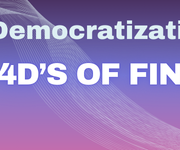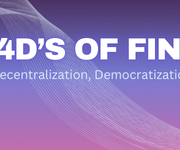There was a time when financial services were largely the domain of the elite, tucked away behind mahogany desks and gatekeepers armed with credit scores, rigid regulations, and stiff dress codes. But the tides have turned, and with the rise of technology, finance is shedding its exclusive image. Today, the democratization of finance aims to make financial services accessible to a wider population, especially those who’ve traditionally been left on the sidelines.
The goal? To create an open playing field where access to loans, savings, and investment opportunities is no longer a luxury but a right. Through innovative models like microfinance and peer-to-peer (P2P) lending, platforms such as Tala and Kiva are setting a new standard for inclusion, offering real solutions to underserved populations. But, as with all grand endeavors, democratization comes with its own set of challenges—from technological and regulatory barriers to the crucial question of financial literacy.
The Democratization Mission: Finance for All
At its core, democratization is about breaking down the barriers that have historically excluded vast populations from accessing financial services. In practical terms, this means opening up resources so that anyone, from a farmer in Kenya to a single parent in rural America, can access the loans, savings, and investment options they need to improve their lives.
The benefits of democratization are profound. For one, it promotes economic growth by empowering individuals to start businesses, invest in education, and manage their resources more effectively. Moreover, democratizing finance fosters resilience: people who can access financial services are better equipped to handle crises, whether they’re health emergencies, crop failures, or economic downturns. The impact is personal, immediate, and powerful.
Microfinance: Small Loans with a Big Impact
Microfinance was one of the earliest models aimed at making finance accessible to underserved communities. By providing small loans to individuals who lack access to traditional banking services, microfinance has unlocked opportunities for millions worldwide. These loans aren’t just numbers on a ledger; they enable people to start businesses, improve their homes, and invest in their futures.
One of the pioneers in this space is Kiva, a nonprofit organization founded in 2005 that connects borrowers and lenders through an online platform. Kiva enables individuals from around the world to contribute as little as $25 to fund a microloan. Unlike traditional financial institutions, which rely on credit scores, Kiva partners with local field organizations that evaluate the borrower’s potential based on community insights. This person-to-person approach has been incredibly successful, with Kiva facilitating over $1.5 billion in loans across 80 countries and achieving a repayment rate of around 96%.
Microfinance works well because it leverages community support and local knowledge, often bypassing the stringent requirements that come with bank loans. However, high-interest rates remain an issue due to the costs associated with managing small, unsecured loans. Still, for borrowers who have no other options, microfinance can be a transformative resource.
Peer-to-Peer Lending: Connecting Borrowers and Lenders Directly
While microfinance opens doors for small entrepreneurs, peer-to-peer lending (P2P) goes a step further by connecting everyday borrowers with individual lenders on a larger scale. These platforms provide an alternative to traditional banks, bypassing intermediaries and reducing the costs associated with loans. P2P lending platforms, like LendingClub and Prosper, have risen to prominence in developed countries, allowing borrowers to secure funds for various purposes—from consolidating debt to launching a new business.
Tala, a mobile-based platform, demonstrates the power of P2P lending in emerging markets. Operating in countries like Kenya, the Philippines, and Mexico, Tala offers microloans based on alternative data, including smartphone usage and other behavioral indicators, rather than traditional credit scores. In doing so, Tala brings credit to individuals who would otherwise be deemed “unbankable.” By assessing creditworthiness through data often overlooked by traditional institutions, Tala has managed to distribute over $1 billion in loans to millions of users.
The beauty of P2P lending lies in its simplicity and accessibility, but challenges persist. The risk of default is higher compared to traditional loans, and P2P platforms sometimes impose high-interest rates to offset this risk. Moreover, P2P lending is still largely unregulated in many parts of the world, which can leave lenders vulnerable.
Overcoming Barriers to Accessibility
While democratization brings substantial benefits, it also faces some serious hurdles. Here’s a closer look at three of the biggest barriers to widespread financial inclusion and how technology is attempting to address them:
- Financial Literacy
Democratization of finance won’t mean much if people don’t understand how to use these new tools. Financial literacy—understanding budgeting, managing debt, and investing—is essential for anyone who wants to use financial services effectively. Unfortunately, this is a skill set that many underserved populations have not had the opportunity to acquire. To address this, platforms like Kiva and Tala integrate financial education into their services, helping users make more informed decisions. However, there’s still a long way to go in making financial literacy widespread. - Access to Technology
Many of the populations that stand to benefit most from democratized finance lack consistent access to technology, particularly smartphones and the internet. While mobile technology has spread rapidly, gaps in coverage remain, particularly in rural and remote areas. Platforms like Tala have adapted by developing lightweight mobile applications that require minimal data, making them accessible even in low-bandwidth regions. Additionally, partnerships with mobile providers to expand coverage in underserved areas have proven effective in increasing access. - Regulatory Hurdles
Financial inclusion is an attractive goal, but regulatory frameworks lag behind technological innovation. Many governments are still figuring out how to handle the rise of digital financial services, and in some cases, the response has been restrictive rather than enabling. To overcome this, organizations like the World Bank and the International Monetary Fund have been working with governments to develop inclusive policies that balance innovation with consumer protection. Regulatory clarity is crucial for scaling democratized finance models, ensuring that these platforms operate fairly and safely.
Looking Ahead: The Future of Democratized Finance
Democratizing finance is more than just a passing trend—it’s a fundamental shift in how we think about access to money and economic power. It’s no longer about whether people should have access to financial services, but about how we can make it possible for them to do so. This shift is creating an ecosystem that’s more inclusive, allowing people from all backgrounds to participate in the global economy.
Yet democratization is also revealing the deep-seated issues in the financial world, highlighting the fact that barriers to entry are not just economic but systemic. Financial institutions, policymakers, and tech innovators will need to work together to create solutions that address both the visible and invisible barriers to access.
Whether it’s the ability to borrow $100 to start a business or the chance to invest in a small company halfway across the globe, democratization is reimagining finance as a space where everyone can participate. And though challenges remain, the potential for technology to bridge these gaps has never been more promising. As access expands, so does the potential for empowerment—one small loan, one P2P connection, and one newly banked individual at a time.


